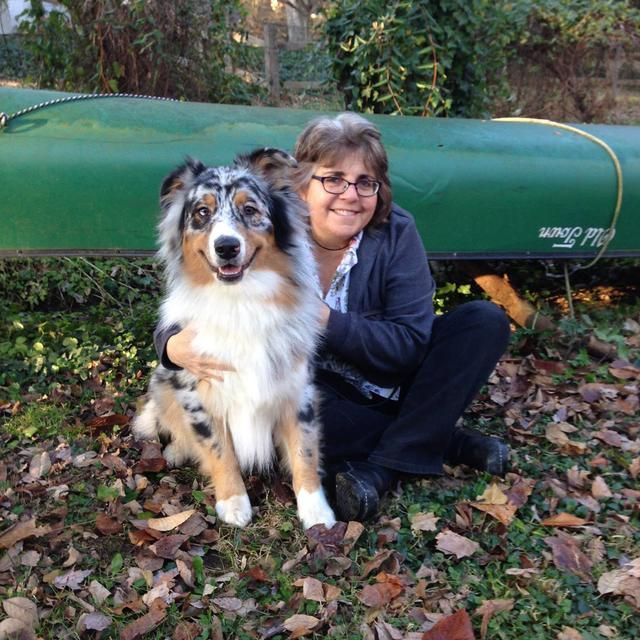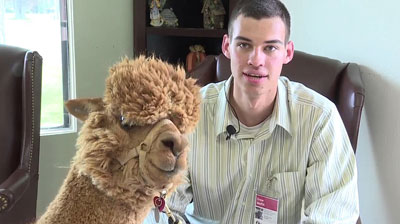Should Young Children Have A Service Dog?
Dr. Ilana Reisner, Veterinary Behaviorist
 In a recent NBC Today Show segment, a 3-year-old girl born with a debilitating lung disease was given a service dog to help her maneuver around with the always-present oxygen tank. The use of service dogs for young children is increasing in popularity. There are service dogs assigned to children with autism and other special needs. From the perspectives of veterinary behavioral medicine and dog bite safety for children, this trend deserves a second look according to Dr. Ilana Reisner. She says, "Children don't understand the limitations of their canine charges."
In a recent NBC Today Show segment, a 3-year-old girl born with a debilitating lung disease was given a service dog to help her maneuver around with the always-present oxygen tank. The use of service dogs for young children is increasing in popularity. There are service dogs assigned to children with autism and other special needs. From the perspectives of veterinary behavioral medicine and dog bite safety for children, this trend deserves a second look according to Dr. Ilana Reisner. She says, "Children don't understand the limitations of their canine charges."
According to Dr. Reisner, she thinks the idea of service dogs for children is a good idea and the intention is wonderful, but there are some problems that it can be fraught with. This is because we're dealing with a living animal and we're dealing with a young child. She is concerned about risks of bites to children and the stress to animals. It's a particular interest of hers to look at dog bite safety.
The amount of dog bites to young children by service dogs is really an unknown. However, we all know how trying a child can be. Dogs are very patient, and cats too, but if you push them over the line, they may attack. Dr. Reisner doesn't think it's terribly common, because she doesn't think it's common that we have service dogs for children.
Service dogs in general, dogs who work, are in theory pretty well socialized and tolerant of all kinds of people and other stimuli around them. But we're talking about something very specific here, which is to pair a dog with a young child, a preschooler or a young school child. In cases like that, there really is nothing magical about having been certified as a service dog. They're still dogs and they're able to feel fear, for example, if they're trapped or if they're manipulated in some ways that they find threatening. While the child deserves to have assistance, it's ultimately the parents who have to be responsible for everything that child does.
 In a recent segment on NBC's Today Show, a little girl named Alida was seen climbing, swinging and in the studio for an interview with her parents, Aaron and Debbie Knobloch. In each shot and in the studio, the young Mr. Gibbs, her service dog, was present. In a small voice, Alida tells him (complete with an impressive hand signal) to "down." In the video and, especially in the studio, Alida pulled on Mr. Gibbs' leash and teased him a bit with a bandana (which he gamely tried to catch). All of which seems harmless enough and, for most viewers, easily outweighed by the benefits of the bond between a great kid and an amazing dog.
In a recent segment on NBC's Today Show, a little girl named Alida was seen climbing, swinging and in the studio for an interview with her parents, Aaron and Debbie Knobloch. In each shot and in the studio, the young Mr. Gibbs, her service dog, was present. In a small voice, Alida tells him (complete with an impressive hand signal) to "down." In the video and, especially in the studio, Alida pulled on Mr. Gibbs' leash and teased him a bit with a bandana (which he gamely tried to catch). All of which seems harmless enough and, for most viewers, easily outweighed by the benefits of the bond between a great kid and an amazing dog.
However, is it safe to assume that a young child could handle and judge the sensitivities of an animal? No, according to Dr. Reisner. At three years old, a child is not capable of doing that. Even some adults aren't capable of doing that, unfortunately, much of the time. But on this particular segment of this lovely little girl with her service dog, Dr. Reisner wrote a blog post because she noticed some stress signs in the dog. There were some attempts for the dog to try and walk away. The dog also looked away and yawned, which is a pretty well established sign of stress. A little bit of stress isn't going to hurt a dog or a child or anyone terribly. The problem with this is that it might be an indication that the dog might bite one day. This kind of handling from a child will more likely happen throughout each day. So whether it's a surprise or whether it's repeated, there are reasons for the risk to be growing.
To say that no child should have a service dog until they reach a certain age is a hard call, according to Dr. Reisner. This is because children vary from each other and some are more mature at the age of eight to 10, than others might be. Realistically, she thinks that we'd be looking more realistically at an age of 8 to 12. But of course, this depends what the dog is a service dog for. So if the child has some social impairment, for example, this might be even more of a challenge to expect them to navigate the dog's moods so that they're safe as well.
Every situation should be examined carefully, according to Dr. Reisner's, and look to see if the child might find assistance and help through other means, like maybe a teaching assistant in schools or having someone supervise the care of a child and not assigning an animal one-on-one to a child.
There was one particular story that Dr. Reisner saw pictures of, where a child that was on the spectrum (autistic) had a dog leash attached to her waist so that when she walked around the dog would follow. This is very dangerous and not a brilliant idea, as a child could be knocked down, and she strongly discourages this.
Surprisingly, Dr. Reisner doesn't hear a lot of opposition to her stance on young children not having service dogs. She thinks it is because at this point it's still relatively new and people aren't coming back about it. However, just the use of service dogs is also a little bit controversial in general, because of the types of training that the dealers claim to have given them.
In fact, there recently was news about a service dog organization that sold a dog that turned out to be aggressive and there was some controversy with what the training involved.
Having a service dog is such a broad topic and it depends so much on the dog's background and also on the person with special needs who is taking responsibility for the dog's care. Dr. Reisner says we are really looking at safety and welfare of both the child and the dog.
Visit Website
Do Animals Have a Musical Ability?
Dr. Henkjan Honing, The Evolving Animal Orchestra
 Darwin believed that musicality was a capacity of all animals, human and nonhuman. Dr. Henkjan Honing is researching how animals respond to music. He tells Animal Radio what he has learned about how dogs, birds, monkeys, sea lions and cockatoos interpret musical nuance.
Darwin believed that musicality was a capacity of all animals, human and nonhuman. Dr. Henkjan Honing is researching how animals respond to music. He tells Animal Radio what he has learned about how dogs, birds, monkeys, sea lions and cockatoos interpret musical nuance.
Dr. Henkjan Honing researches animals and music. He says that all humans possess the trait of musicality and that some animals do as well, which is dependent on your definition of musicality.
Most of Dr. Honing's colleagues agree that you need at least two things to be musical as a human or an animal. One is that you are sensitive to the beat and can hear the regularity and can dance to the music. He states it's very difficult to find someone who can't pick up the regularity in the music. The other thing is relative pitch. This means that you can recognize the melody, whether it is sung higher or lower, slower or a faster, and you still know what it is.
Everyone has probably seen the video of Snowball the Cockatoo bopping his head to some music. The bird actually has sensitivity to the musical aspects of sound. Darwin thought that all animals should be sensitive to melody and to rhythm. But until 2009, no animal was found who could do that. However, Snowball was discovered in 2007. Snowball was the first actual animal for which it was shown that he is sensitive to the regularity of the music. If the music goes faster, he dances faster. If the music goes slower, he moves slower. This means he is listening. This has been very difficult to find in other animals. Dogs for instance, can't do that and horses can't do that.
Dogs don't obviously bop around to the beat of a song, so do they have any musical taste whatsoever? Dr. Honing tells us that they're sensitive to sounds for sure and they're very sensitive to speech, as all pet owners know. They also have a very good memory for particular sounds. However, there has not ever been found a dog that can move to the music by itself and will move faster as the music goes faster. So if there is a pet owner who has a dog that can do that, film him please! It would be a very important paper. But so far we have no evidence that dogs or cats can do this.
We've all seen experiments where music is played in shelters for dogs, which was found to decrease kennel stress and their anxiety in certain situations. So while music still has an effect on them, the music is not compelling them to act in a way that we perceive as enjoyment of the music.
The big difference between the listening strategies or the listening predispositions between humans and some other species is that we pay attention to melody and rhythm, according to Dr. Honing.
 Dr. Honing still thinks that the mystery with dogs and music is what do they pay attention to? Just like also with some birds, they might pay attention to completely different sounds then that we pay attention to. If you listen to music, we hear melodies and we hear rhythms. However, it turns out that some other animals actually hear more like the way we listen to speech. So they'll listen more for the changing sounds. We are sensitive to the changes of sound quality over time. Those are the words that you're listening to and you are less sensitive to the pitches, which its more in the background. It's more like by intonation or whether someone is posing a question or not. It does seem that birds are listening to music more so as if it was speech. They listen to the change of sounds and less so to the pitches and the melodies that we tend to listen to when we listen to music.
Dr. Honing still thinks that the mystery with dogs and music is what do they pay attention to? Just like also with some birds, they might pay attention to completely different sounds then that we pay attention to. If you listen to music, we hear melodies and we hear rhythms. However, it turns out that some other animals actually hear more like the way we listen to speech. So they'll listen more for the changing sounds. We are sensitive to the changes of sound quality over time. Those are the words that you're listening to and you are less sensitive to the pitches, which its more in the background. It's more like by intonation or whether someone is posing a question or not. It does seem that birds are listening to music more so as if it was speech. They listen to the change of sounds and less so to the pitches and the melodies that we tend to listen to when we listen to music.
But what about primates? Since they're closest to humans, do they feel music and interpret music the same way we do? This is something Dr. Honing had hoped for. In his book, he describes his trip that he made in the last few years where he visited many labs and conducted many experiments. He said that you would expect that from another primate, especially monkeys, since they have brains that are very similar to ours. However, it turns out that after repeat experiments, it was found that they are not sensitive to the beat of music. They're also not sensitive to relative pitch. This means they can't recognize melodies that are transposed just a little bit higher or lower, as being the same melody.
There was also a study of Ronan, a sea lion, who was trained to move her head to a beat. However, if the beat was changed, would she be able to pick up on that or was she only trained to one particular song or beat? Dr. Honing says that that was a beautiful study. He met Ronan about four years ago for the first time. He said she's a wonderful animal and she was very excited to do listening experiments and wanted to join. When she was listening to different types of rhythms, whether it was fast or slow, she was almost always faster than Dr. Honing was. He was behind the fence watching her doing the same experiment that she did the year before, which was published in a journal. There was one song for instance, by Earth, Wind & Fire (Boogie Wonderland) that was played relatively fast and she had the downbeats quicker than he had. Dr. Honing was really moved to see this animal having so much pleasure in head banging to this strange music to her. In fact, he fell in love with her and she even gave him a kiss on his cheek.
In his new book, The Evolving Animal Orchestra, Dr. Honing shows us that science is closing in on the biological and evolutionary source of our musicality.
Visit Website
Don't Litter - Spay or Neuter Instead! - Dr. Debbie
 World Spay Day is February 26, 2019. Do you believe your beautiful pedigreed pooch just has to be bred, or that your cat can't possible get outside to become pregnant, or that you long to have just one litter from Fluffy? If so, listen in to the unified pet health message of Spay Day. Shelter staff, veterinarians, and animal advocates all join together to encourage spaying and neutering. It's the right thing to do for your pet's health, and is a step forward in addressing pet overpopulation issues. With approximately 4 million dogs and cats euthanized at U.S. shelters every year, pet owners can do their part to avoid unintended and unnecessary breeding.
World Spay Day is February 26, 2019. Do you believe your beautiful pedigreed pooch just has to be bred, or that your cat can't possible get outside to become pregnant, or that you long to have just one litter from Fluffy? If so, listen in to the unified pet health message of Spay Day. Shelter staff, veterinarians, and animal advocates all join together to encourage spaying and neutering. It's the right thing to do for your pet's health, and is a step forward in addressing pet overpopulation issues. With approximately 4 million dogs and cats euthanized at U.S. shelters every year, pet owners can do their part to avoid unintended and unnecessary breeding.
Your individual decisions on altering your pet do matter. Animals, left to do what they will, result in a lot of generations of whiskers and tails in just a short period of time. A pair of dogs can produce 67,000 puppies in 3 years' time. And cats in that same time frame can prosper to over 420,000 kittens.
Common Spay & Neuter Fallacies:
Isn't it better to let my female dog go into heat before I spay her?
FALSE. You can minimize the risk of breast cancer to zero by spaying before the first heat. Allow her to have a few heat cycles, and your dog has a 25% chance of developing breast cancer. The health benefits for females also include preventing uterine cancer and the life-threatening reproductive infection, pyometra.
Isn't it better to let a female dog have at least one litter of pups?
FALSE. There is no psychological or health benefit in allowing a female dog to have a litter. It does not make her a better, more affectionate pet. On the contrary, some pregnant female dogs are quite protective and aggressive to anyone disturbing her brood.
My dog is a purebred dog with a pedigree so it is meant to be bred.
FALSE. Having purebred papers doesn't mean an animal has to be bred. There is no shortage of purebred animals, with purebred dogs accounting for 30% of all animals currently in shelters.
 It's a great experience to allow children witness the beauty of birth by letting your pet have a litter.
It's a great experience to allow children witness the beauty of birth by letting your pet have a litter.
STOP. What really is beautiful is to impart children with a sense of value toward animal life. Yes, birth is a miracle to behold. But there are many books and videos that demonstrate birth in a responsible manner, without unnecessary pet breeding.
Teach your children to care for your existing pets, from puppyhood or kitten hood until senior pet years. Children learn responsibility while caring for a pet and develop an appreciation for the human-animal bond by living it daily.
Won't spaying or neutering my pet make my pet fat?
FALSE. You directly control what, when and how much your pet eats. The fate of your pet's waistline lies in your hands. Your pet's metabolism may slow down some after spaying or neutering, but with sensible feeding and regular exercise you can maintain a healthy weight for your pet.
It's expensive to spay or neuter my pet.
FALSE. There are many affordable solutions to ensuring your pet is spayed or neutered. Some veterinary hospitals and shelters offer special programs on Spay Day. And other facilities offer year round low-cost options.
Still not convinced spaying & neutering is worth it? Consider that the cost of spay or neuter is less than the cost of raising kittens or pups for a year. And don't ignore the possible realities of pregnancy problems. An emergency C-section for a pet having labor difficulties costs $1000 or more.
I want my dog to guard the house. Won't spaying or neutering make my pet less protective?
FALSE. There is no relation between your pet having reproductive organs and performing as a guard dog. A dog's protective behavior is based on instinct and training. Surgically spaying or neutering doesn't change your pet's devotion to protect home and family members. And once a dog is spayed or neutered, it has less desire to roam away from home to find a mate.
Take action now.
Of course you want to do what's best for your pet. Life is busy with family demands, work and a stream of errands. But don't delay this important step to keep your pet healthy for a lifetime together with you.
For more information on Spay Day visit the Humane Society.
Featured veterinarian known as "Dr. Debbie" on national pet radio program, Animal Radio. Ebook author of "Yorkshire Terriers: How to Be Your Dog's Best Friend"; "Pugs: How to Be Your Dog's Best Friend"; "Mini Schnauzers: How to Be Your Dog's Best Friend"; and "Shih Tzu: How to Be Your Dog's Best Friend." Dr. Debbie's books.
Visit Website
 The Dogfather's Grooming Tip with Joey Villani
The Dogfather's Grooming Tip with Joey Villani
Tips To Make Grooming Elderly Pets Easier On Them
Most of the time when things happen in a grooming salon, chances are it will happen with a senior dog.
Dog breeds reach their twilight years at different times. For a large dog, this can be anywhere from eight years and up, and for small dogs, anywhere from 10 years and up. When you take your senior dog (or any aged dog for that matter) to a groomer, the last thing that you want to get is a phone call that something serious has happened to your pet.
You can help make it easier for your dog to go to a groomer by actually starting at home, which is really important. If you have a puppy, you should start them out by brushing and combing them. However, if you didn't do this when they were a puppy, it's probably even more important as they get older to prepare them before they go into a salon.
As your dog ages, you probably are going to notice that they are getting a little more crotchety. Even cats do this. They just seem to get a little bit more anxious as they get older. Joey has known people who have said that their dogs never bit them and all of a sudden when they started brushing them as they were older, the dog bit them.
A grooming session might be a little overwhelming for an older dog, even if they have been groomed all of their life. So to make it easier, you can start at home. When grooming your pet, start with a section their body. Instead of doing the whole body, pick a couple of days during the course of a week and brush out just one area. One day you could brush out their legs, do their torso on another day, and then head on another day, while doing their tail on yet again another day. You want to get them knot free so when they actually go to a groomer, it's a little bit easier for everyone.
 Besides brushing, sometimes the bathing process is a little difficult for a senior dog. Joey likes to use cornstarch and then add a couple of drops of lavender essential oil to it. Shake the mixture up well and then let it sit on the shelf 24 hours. After that, just sprinkle it over your dog and brush it out. This will help absorb the dirt and oil. Now you have a dog that's a little bit cleaner.
Besides brushing, sometimes the bathing process is a little difficult for a senior dog. Joey likes to use cornstarch and then add a couple of drops of lavender essential oil to it. Shake the mixture up well and then let it sit on the shelf 24 hours. After that, just sprinkle it over your dog and brush it out. This will help absorb the dirt and oil. Now you have a dog that's a little bit cleaner.
When it comes to clipping the nails most animals don't like it. So instead of cutting all of the nails at every six to eight weeks, cut them regularly, at least once a week, by just taking off the tips so it's not so traumatic for them.
If your dog has never been to a groomer, go visit the groomer without actually having an appointment. If they are willing, have them give your dog a treat so your dog will start to associate the place as a good place. Joey doesn't know too many groomers who would say no to this. He would personally welcome this because he would then be talking to a conscientious pet owner that's trying to be proactive and makes his life easier.
Unfortunately grooming salons are loud, mainly because of the high velocity dryers. Joey has noticed that this noise seems to startle older dogs a little bit more. So if you do take your dog in a salon to get them used to it, walk around the salon with your dog and make it a fun day out.
All of these things will make your elderly dog much happier and less stressful for them when they need to be seen by a professional groomer.
Animal Radio News - Lori Brooks
 FBI Investigates Pet Scams
FBI Investigates Pet Scams
The FBI has issued a warning on pet adoption scams along with ways to avoid getting duped. One of those ways is what they call "building a digital defense" against pet adoption scams. Beth Anne Steele of the FBI says, "Fraudsters are prowling the web to find families who are so desperate for the perfect pooch that they are willing to adopt sight unseen." The scam usually starts when someone comes across a pet adoption ad online then unwittingly engages with the scammer and proceeds to pay a series of fees. However, the pet never arrives. Fraud.org says, "Regardless of how much money is sent, the phony seller will find new reasons to ask for additional payment. This continues until the victim, now often out thousands of dollars, catches on and stops sending money." Fraud.org says popular online ad sites such as Craigslist and Oodle are often the starting point for these pet scams. The International Pet and Animal Transportation Association (IPATA) says these scams can also originate in local newspapers, email and pet travel sites. The scammers sometimes even pretend to be faith-based organizations where the group even provides a regularly updated list of scammers.
California Pet Blood Bank Modernization Act
The California Pet Blood Bank Modernization Act bill will allow animal blood banks in California to utilize a donor blood collection system for dogs and cats instead of their current model, which is unusually cruel. Currently, California is the only state in the nation that requires animal blood banks to collect blood from "closed colonies," a system in which donor animals are confined to cages in facilities where they are used solely for their blood, sometimes for many years. Every other state uses a volunteer donor model similar to the system we use for humans.
 Emotion Support Alpacas Must Go
Emotion Support Alpacas Must Go
Emotional support animals are in the news in Ohio, where a family is facing a deadline to find new homes for their alpacas, which they consider therapy pets. A neighbor claims the alpacas are a nuisance to the neighborhood, because it's turned his neighbor's backyard into a smelly pasture. The alpaca owners say they've been cooperative with the city and have already re-homed two alpacas. They now claim that they clean up after the remaining duo on a daily basis. These alpacas are not outside all the time though. They are indoor-outdoor pets. The owner claims alpacas are quieter and their poop smells less than a dog's poo. He adds he and his family are willing to do anything within reason to make peace with the neighbor, such as planting tall evergreen trees or extending a privacy fence into the woods.
Be Careful When Adding A Second Dog
If you have a dog and are considering adopting a second one, it can be tricky adding another to the pack, especially if you add a different breed of dog. As a result, UK's Kennel Club (pretty much the equivalent of the American AKC) has put out a list of dogs it says are known for their affectionate and docile temperaments. However, the Kennel Club adds there are some factors to keep in mind when introducing any dog to a new home with existing pets. They include how well trained the dog is, whether it's used to being around other animals and the dog's age. Here is the list of the five popular dog breeds that are known to be gentle, patient and versatile, according to the Kennel Club: 1. Golden Retriever; 2. Cocker Spaniel; 3. St Bernard; 4. English Springer Spaniel; and 5. Newfoundland.
 Goose Steals The Show
Goose Steals The Show
Although Captain Marvel hasn't hit theaters yet, promotional and related merchandise is being released, the most recent of which comes from the Hong Kong-based collectibles brand Hot Toys. The company recently unveiled images of its Captain Marvel character figure holding Goose the cat, which has feline fans buzzing. Despite appearing for only a few seconds at the end of a trailer for the movie, the cat has quickly became the focus of wild fan adoration. According to early reviews of the film, Goose steals the show. The cat's name is an intentional nod to the film Top Gun, in which Goose was Tom Cruise's partner's nickname in the movie.
Hill's Pet Nutrition Food Recall
Hills Pet Nutrition, the makers of Science Diet pet foods, has announced it is voluntarily recalling some of their canned dog food believed to contain a dangerous amount of Vitamin D. Hills says that the Vitamin D was made in the USA and wasn't a foreign sourced ingredient. However, prolonged high intake of vitamin D in dogs can lead to calcification of soft tissues such as the kidneys. Some of the symptoms of too much Vitamin D for animals include vomiting, not wanting to eat, increased drinking and urination, weight loss, joint issues, drooling and a nauseated stomach. The recall affects only certain Hill's Prescription Diet and Hill's Science Diet canned dog foods. When the company posted the recall announcement on its Facebook page, thousands of people shared their story of how their dog became sick, or even died because of the products. That's when the news of the recall became headlines. Of course, those posts can't all be verified, but the company admits there is or was a problem.
 Listen to the entire Podcast of this show (#1003)
Listen to the entire Podcast of this show (#1003)





